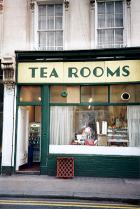 |
Forever Formica |
|
Home
|
"High pressure laminate is selected for its durability, design features, construction versatility and ease of maintenance. Residential applications include kitchen units,worktops, bathroom vanity units and flooring. Formica products are marketed through thousands of locations worldwide by an international independent distributor and dealer network, and by the company's own salesforce. Manufacturers of finished products, architects and designers specify Formica products for commercial and residential interiors. The Formica brand is the
world's leading name in the decorative surfaces market and is
the single most specified brand of high pressure laminate among
homebuilders, contractors and shopfitters." In 1927, the decorative potential of the product was discovered as the company began lithographing images onto sheets of laminate. By the 1930s, a resistant melamine layer was added, giving Formica laminates their legendary durability and ease of maintenance. After World War II, Formica products were benefiting from the housing wave caused by the baby boom in the USA, and began producing laminates in a variety of colours and patterns. The product was so successful that the laminate brand name became universally recognised in the USA... Formica - the hard-wearing practical surface that covered the table and counter tops of Britain's chippys, milk bars and family cafes - has come to signify the everyday, the marvellously mundane. But in its heyday in the 30s, Formica was used in bars, diners and even the Queen Mary liner, as a cheap replacement for lacquer during art deco's insistence on shiny black surfaces. World renowned artists and architects had also begun to recognise the potential of the decorative laminates and specified them for Modernist and Art Deco interiors. By the time of its arrival in Britain from the US around 1947, it exemplified the smooth shiny ultra modern wipe-down luxury lifestyle of the US with its alluring exotic patterns, bright colours and wood grain effects. After WW2, Formica became a mainstay of the UK's make-do-and-mend DIY culture and the post-war building boom. The general conformity of the times making it possible for just one or two patterns to become massive sellers. As colour seeped back into British life, the simple, cheerful optimism of Formica pattern-names indicated a brave new fuss-free world: Spindrift, Mayflower, Skylark, Softglow, Lynette... The many commercial applications for Formica products include work surfaces, furniture, flooring, counter tops and interior walls. You'll come across Formica laminates in offices, airports, hospitals, schools, restaurants, hotels, retail outlets, leisure facilities, ships, buses and trains across the world. For decades, Formica seemed to be on the verge of laminating the entire world. But the 70s were Formica's dog days. It lost its grip on the domestic market and the phrase 'cracked Formica' seemed to appear more and more often in books and magazines indicating a soiled, worn out product whose time was up. Though it remains to this day a key symbol of a mass market product , the recent 90s vogue for modern minimalist interiors has made Formica fashionable again. Ironic that a substance originally meant
to mimic a material used in the electrical industry has now developed
a real uniqueness and authenticity all of its own...
|

